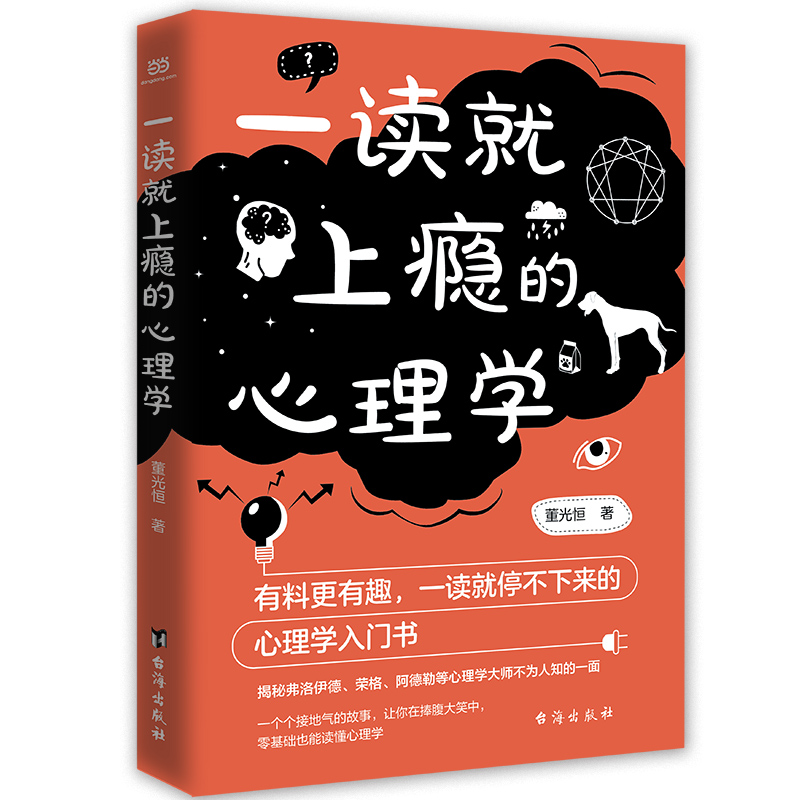
動機(jī)與人格(第3版)·英文版
出版時間:2021-12-29
作者:亞伯拉罕·馬斯洛(Abraham H.Maslow
出版社:清華大學(xué)出版社
¥96.70¥129.00
書籍詳情
編輯推薦:
亞伯拉罕·馬斯洛,國際上*有影響力的心理學(xué)家之一,開拓了心理學(xué)史上的第三思潮——“人本主義心理學(xué)”,被譽(yù)為“人本主義心理學(xué)之父”。《動機(jī)與人格》是馬斯洛*經(jīng)典的著作。
應(yīng)用的領(lǐng)域較廣
本書在心理學(xué)、管理學(xué)、教育學(xué)、社會學(xué)、哲學(xué)等領(lǐng)域都享有盛譽(yù),為多個領(lǐng)域的研究者所熟悉。
具備新版的特點(diǎn)
內(nèi)容簡介:
本書是“人本主義心理學(xué)之父”馬斯洛的代表作,本書奠定了馬斯洛的學(xué)術(shù)地位。本書 中,馬斯洛提出了許多精彩的理論,其中需求層次理論、自我實現(xiàn)理論、高峰體驗理論*為廣大讀者所 熟悉。本書自1954年初版后,對管理學(xué)、心理學(xué)、教育學(xué)、社會學(xué)等學(xué)科領(lǐng)域和實際工作產(chǎn)生了巨大的 影響力。 本書是一部經(jīng)典的、解讀“人性”的著作。閱讀本書,就如同在傾聽自己內(nèi)心的聲音。它并不晦澀 難懂,適合每一位想了解自己、了解人性的讀者閱讀。
作者簡介:
馬斯洛(1908—1970),“人本心理學(xué)之父”,當(dāng)代偉大的心理學(xué)家之一,曾擔(dān)任美國心理學(xué)學(xué)會主席。《動機(jī)與人格》是他重要的著作之一,奠定了他的學(xué)術(shù)定位。
美國知名作家、教育家喬治?倫納德評價他說:在改變我們對人性和人類可能性的看法方面,亞伯拉罕?馬斯洛所做的,比過去50年中其他任何一位美國心理學(xué)家所做的都要多。他的影響,仍在繼續(xù)直接或間接地增長,特別是在健康、教育和管理理論領(lǐng)域,以及在幾百萬美國人的私人和社會生活中。
目 錄:
第3版序第2版序
寫在前面的話
亞伯拉罕·馬斯洛的影響 51
引言 51
馬斯洛的影響 52
生平簡歷 56
參考文獻(xiàn) 65
第1部分
動機(jī)理論 1
第1章 動機(jī)理論引言 2
作為一個整體的個人 2
作為動機(jī)狀態(tài)典型的饑餓 3
第3版序
第2版序
寫在前面的話
亞伯拉罕·馬斯洛的影響 51
引言 51
馬斯洛的影響 52
生平簡歷 56
參考文獻(xiàn) 65
第1部分
動機(jī)理論 1
第1章 動機(jī)理論引言 2
作為一個整體的個人 2
作為動機(jī)狀態(tài)典型的饑餓 3
2
Motivation and Personality
THIRD EDITION
手段和目的 5
無意識動機(jī) 6
欲望與文化 6
復(fù)雜多樣的動機(jī) 7
促動狀態(tài) 8
滿足產(chǎn)生新的動機(jī) 9
不可能列出內(nèi)驅(qū)力一覽表 10
按照基本目標(biāo)為動機(jī)分類 12
動物資料不足以說明問題 12
環(huán)境 14
整合作用 16
無動機(jī)的行為 17
達(dá)到目的的可能性 18
現(xiàn)實和無意識 18
健康人的動機(jī) 21
第2章 人類動機(jī)理論 22
基本需要的層次 22
基本的認(rèn)知需要 36
基本需要的特點(diǎn) 41
第3章 基本需要的滿足 52
滿足一個基本需要所產(chǎn)生的一些后果 53
學(xué)習(xí)和需要的滿足 56
需要滿足和性格形成 58
滿足和健康 62
滿足和病態(tài) 65
需求滿足理論的應(yīng)用 66
滿足的影響 70
3
目錄
第4章 重新考察本能理論 75
重新考察本能理論的重要性 75
對傳統(tǒng)本能理論的批判 77
類本能理論中的基本需要 86
第5章 需要的層次 92
高級需要與低級需要的差異 93
需要層次存在的后果 97
第6章 非動機(jī)的行為 103
應(yīng)對與表達(dá) 105
表達(dá)性行為 115
第2部分
心里病態(tài)與正常狀態(tài) 121
第7章 心理病理的起源 122
剝奪與威脅 122
沖突和威脅 125
威脅的個體化定義 128
作為威脅的精神創(chuàng)傷和疾病 129
作為威脅的對自我實現(xiàn)的抑制 130
病理狀態(tài)的根源 131
總結(jié) 132
第8章 破壞性是本能的嗎? 133
動物 134
兒童 138
人類學(xué) 142
臨床經(jīng)驗 143
來自內(nèi)分泌學(xué)、遺傳學(xué)等的材料 144
一些理論上的考慮 145
破壞性:本能還是習(xí)得? 148
第9章 作為良好人際關(guān)系的心理治療 150
心理治療與需要滿足 153
良好的人際關(guān)系 159
良好社會 171
專業(yè)的心理治療 176
第10章 達(dá)到正常與健康的方法 182
“正常”的標(biāo)準(zhǔn)概念 184
新的概念 187
我們可以成為什么 189
內(nèi)在的人性 193
從非本質(zhì)屬性中區(qū)分出固有屬性 195
健康的前提條件 197
環(huán)境與人格 199
心理學(xué)烏托邦 200
“正常”的本質(zhì) 201
第3部分
自我實現(xiàn) 203
第11章 自我實現(xiàn)的人 204
研究 205
觀察結(jié)果 209
第12章 自我實現(xiàn)者的愛情 247
開放性 248
愛與被愛 248
性 249
對自我的超越 252
嬉戲與娛樂 253
對他人的尊重 253
作為對自身獎賞的愛情 255
利他主義的愛 257
分離與個性 258
第13章 自我實現(xiàn)者的創(chuàng)造性 260
先入之見 260
新的范例 261
自我實現(xiàn)的創(chuàng)造性 263
“非此即彼”的消解 265
沒有恐懼感 267
高峰體驗 268
創(chuàng)造性的層次 271
創(chuàng)造性與自我實現(xiàn) 275
第4部分
人類科學(xué)的方法論 277
第14章 新心理學(xué)的問題 278
學(xué)習(xí) 279
知覺 280
情緒 281
動機(jī) 282
智力 284
認(rèn)知和思維 285
臨床心理學(xué) 286
動物心理學(xué) 288
社會心理學(xué) 289
人格 294
第15章 關(guān)于科學(xué)的心理學(xué)研究 296
對科學(xué)家的研究 297
科學(xué)和人類價值 297
理解的價值觀 298
人類和自然界的規(guī)律 299
科學(xué)社會學(xué) 300
認(rèn)識實在的各種方法 300
心理健康 303
第16章 方法中心與問題中心 305
過分強(qiáng)調(diào)技術(shù) 305
方法中心與科學(xué)上的正統(tǒng) 310
第17章 陳規(guī)化的認(rèn)知與真正的認(rèn)知 315
注意 316
感知 321
學(xué)習(xí) 324
思想 331
語言 339
理論 341
第18章 心理學(xué)的整體論方法 344
整體動力學(xué)方法 344
人格癥候群的概念 355
人格癥候群的特征 361
研究人格癥候群 373
人格癥候群的層次與特性 380
人格癥候群和行為 382
癥候群資料的邏輯和數(shù)學(xué)表達(dá) 385
后記 亞伯拉罕.馬斯洛的豐碩成果 391
引言
人本心理學(xué) 402
介紹 402
心理學(xué) 407
后人本心理學(xué) 412
教育:人本主義價值觀及新的學(xué)習(xí)方法 416
馬斯洛對工作與管理的影響 421
健康與全人 425
動機(jī)、自我實現(xiàn)理論與女性心理學(xué) 428
協(xié)同性社會 430
持續(xù)不斷的收獲 435
動機(jī)與人格的引文回顧 435
參考文獻(xiàn)與選讀 438
亞伯拉罕·馬斯洛的著作參考文獻(xiàn) 448
人名索引 468
主題標(biāo)引 471
CONTENTS
PREFACE TO THE THIRD EDITION
PREFACE TO THE SECOND EDITION
Foreword
THE
INFLUENCE
OF
ABRAHAM
MASLOW
51
By Robert Frager
Introduction 51
Maslow’s Influence 52
A Short Biography 56
References 65
ONE
MOTIVATION
THEORY
1
Chapter 1 Preface to Motivation Theory 2
Holistic Approach 2
A Paradigm for Motivational States 3
Means and Ends 5
10
Motivation and Personality
THIRD EDITION
Unconscious Motivation 6
Commonality of Human Desires 6
Multiple Motivations 7
Motivating States 8
Satisfactions Generate New
Motivations 9
Impossibility of Listing Drives 10
Classifying Motivation According to
Fundamental Goals 12
Inadequacy of Animal Data 12
Environment 14
Integrated Action 16
Unmotivated Behaviors 17
Possibility of Attainment 18
Reality and the Unconscious 18
Motivation of Highest Human Capacities 21
Chapter 2 A Theory of Human Motivation 22
The Basic Need Hierarchy 22
The Basic Cognitive Needs 36
Characteristics of the Basic Needs 41
Chapter 3 Gratification of Basic Needs 52
Consequences of Satisfying a Basic Need 53
Learning and Gratification 56
Gratification and Character Formation 58
Gratification and Health 62
Gratification and Pathology 65
Implications of Gratification Theory 66
Influence of Gratification 70
11
CONTENTS
Chapter 4 Instinct Theory Reexamined 75
The Importance of Reexamination 75
Critique of Traditional Instinct Theory 77
Basic Needs In Instinct Theory 86
Chapter 5 The Hierarchy of Needs 92
Differences Between Higher and Lower Needs 93
Consequences of a Hierarchy of Needs 97
Chapter 6 Unmotivated Behavior 103
Coping Versus Expression 105
Expressive Behaviors 115
TWO
PSYCHOPATHOLOGY
AND
NORMALITY 121
Chapter 7 Origins of Pathology 122
Deprivation and Threat 122
Conflict and Threat 125
Individual Definition of Threat 128
Trauma and Illness as Threat 129
Inhibition of Self-Actualization as Threat 130
The Source of Pathology 131
Summary 132
Chapter 8 Is Destructiveness Instinctive? 133
Animals 134
Children 138
Anthropology 142
12
Motivation and Personality
THIRD EDITION
Clinical Experience 143
Endocrinology and Genetics 144
Theoretical Considerations 145
Destructiveness: Instinctive or Learned? 148
Chapter 9 Psychotherapy as Good Human
Relationships 150
Psychotherapy and Need Grtification 153
Good Human Relationships 159
The Good Society 171
Professional Psychotherapy 176
Chapter 10 Approaches to Normality and Health 182
Standard Concepts 184
New Concepts 187
What We May Become 189
Inherent Human Nature 193
Differentiating the Inherent from the Accidental 195
Conditions for Health 197
Environment and Personality 199
Psychological Utopia 200
The Nature of Normality 201
THREE
SELF-ACTUALIZATION 203
Chapter 11 Self-actualizing People:A Study of
Psychological Health 204
The Study 205
The Observations 209
Chapter 12 Love in Self-actualizing People 247
Openness 248
To Love and Be Loved 248
Sexuality 249
Ego-Transcendence 252
Fun and Gaiety 253
Respect for Others 253
Love As Its Own Reward 255
Altruistic Love 257
Detachment and Individuality 258
前 言:
PREFACE TO THE THIRDEDITION
Motivation and Personality is an original record of the work in
progress of one of the most creative psychologists of this century. It
has become a primary reference for anyone interested in Abraham H.
Maslow’s theories, as clearly evidenced by growing attention from
authors in many major professional journals in psychology, education,
business, and social studies, among other fields. Although the first
edition of this book was published in 1954 and the second in 1970, its
PREFACE TO THE THIRD
EDITION
Motivation and Personality is an original record of the work in
progress of one of the most creative psychologists of this century. It
has become a primary reference for anyone interested in Abraham H.
Maslow’s theories, as clearly evidenced by growing attention from
authors in many major professional journals in psychology, education,
business, and social studies, among other fields. Although the first
edition of this book was published in 1954 and the second in 1970, its
influence has continued to grow over the years. From 1971 to 1976,
Motivation and Personality was cited as a reference 489 times, an
average of over 97 references a year. From 1976 t0 1980, more than
20 years after publication of the first edition, citations rose to 791, an
average of over 198 citations a year.
This third edition of Motivation and Personality has been revised
to highlight Maslow’s creative thinking and emphasize his far-reaching
concepts. Within the text itself, we have reordered the chapters,
added new headings and subheadings in one chapter, and deleted a
few sections of dated material. Chapter 13 is a new addition to this
book. It is the text of a lecture Maslow gave in 1958 at Michigan State
University. In the hope of enhancing the reader’s sense of the historical
18
Motivation and Personality
THIRD EDITION
and intellectual context of the book, several other features have been
added to this edition: a brief biography of Maslow, an afterword on
the extensive effect of Maslow’s vision in contemporary lives, chapter
introductions, a citation study, and a complete bibliography of his
work.
This edition has four major sections: l. Motivation Theory,
- Psychopathology and Normality, 3. Self-Actualization, and
- Methodologies for a Human Science.
Chapter l, “Preface to Motivation Theory,” provides a humanistic
critique of traditional behaviorist theories of motivation. Maslow
systematically lists the limitations of traditional motivation theory.
He emphasizes the need to consider the whole person, the effects of
culture, environment, multiple motivation, nonmotivated behavior,
healthy motivation. In short, Maslow lays out the major foundations
for a truly human theory of motivation.
Chapter 2, “A Theory of Human Motivation,” is a classic
presentation of Maslow’s hierarchy of needs. Maslow provides
a brilliant and elegant integration of behaviorist, Freudian, and
humanistic psychology. The need hierarchy has become a widely
used paradigm in business, advertising, and other applications of
psychology.
Maslow argues that all human needs can be arrranged in a
hierarchy, beginning with physical needs—for air, food, and water.
Next come four levels of psychological needs—for safety, love,
esteem, and self-actualization. Maslow argues that our higher needs
are as real and as integral a part of human nature as our need for food.
He avoids the oversimplifications of both behaviorist and Freudian
positions.
In Chapter 3, “Gratification of Basic Needs,” Maslow explores
some of the implications of his need hierarchy. He discusses need
19
PREFACE TO THE THIRD EDITION
gratification, its consequences, and its relation to leaning, character
formation, psychological health, pathology, and a variety of other
phenomena.
Maslow reexamines the classic psychological theory of instinct
in Chapter 4, “Instinct Theory Reexamined.” This theory applies the
biological concept of instinct to human behavior. Instinctivists look
for the roots of all behavior in inherited instincts, as opposed to the
behaviorists who have tended to explain all behavior in terms of
leaning.
In this chapter, Maslow summarizes the major problems
of the instinctivist approach. He argues that any careful look at
human behavior will show a mixture of the effects of heredity and
environment. Maslow writes that human needs do have an instinctive
component, but generally one that is weak. Normal, healthy human
beings are not dominated by their instinctive needs, nor are they deeply
frustrated if some of their instinctive needs are unfulfilled.
Freud held that the demands of our egos and our culture are
inevitably at odds with our deepest, essentially selfish instincts.
Maslow disagrees. He argues that we are essentially good and
cooperative, that we can be fulfilled by our culture rather than
frustrated by it.
In Chapter 5, “The Hierarchy of Needs,” Maslow discusses
the differences between needs that are higher and those that are
lower in the need hierarchy. He argues that higher needs are later
evolutionary developments and also that they develop later in each
individual. Higher needs are less demanding and can be postponed
longer. Satisfaction of higher needs produces more happiness and
leads to greater individual growth. It also requires a better external
environment.
Next, Maslow explores some of the implications of his hierarchy.
Maslow’s need hierarchy is one way of doing justice to the richness
and complexity of higher human functioning and at the same time
placing human behavior on a single continuum with the motivation
and behavior of all organisms. Maslow also outlines the model’s
implications for philosophy, values, psychotherapy, culture, and
theology.
In Chapter 6, “Unmotivated Behavior,” Maslow expands
traditional psychological concerns to include expressive and artistic
behavior. Behavioral psychologists of his day tended to ignore
everything but learned, motivated behavior. Maslow points out that not
all behavior is motivated or purposive. Expressive behaviors, including
singing, dancing, and play, are relatively spontaneous, unpurposeful,
and enjoyable in their own right. They are also worthy of the attention
of psychology.
Maslow discusses two kinds of need frustration in Chapter 7,
“Origins of Pathology.” Threatening frustration produces pathology.
Nonthreatening frustration does not. Maslow argues that not all
frustration is threatening, and, in fact, deprivation may have positive
as well as negative effects. Maslow also discusses threatening and
nonthreatening conflict, arguing here too that some kinds of conflict
can have positive consequences.
In Chapter 8, “Is Destructiveness Instinctive?,” Maslow argues
that destructiveness is not innate. He reviews evidence from studies
of animals, children, and cross-cultural behavior indicating that in
a healthy, supportive environment there is virtually no destructive
behavior. He argues that for destructiveness, as for any behavior,
we must consider three factors: the individual’s character structure,
cultural pressures, and the immediate situation.
Maslow begins Chapter 9, “Psychotherapy as Good Human
Relationships,” by relating psychotherapy to traditional concepts of
experimental psychology, such as threat, act completion, and need-
gratification.
By acknowledging the central theoretical role of need-gratification,
Maslow argues that we can understand how different therapeutic
systems are all effective and how relatively untrained psychotherapists
can also be effective. He points out that our basic needs can be
satisfied only interpersonally. These include satisfaction of the needs
in Maslow’s need hierarchy—needs for safety, belongingness, love,
and self-esteem.
Maslow argues that good human relations are essentially
therapeutic and, conversely, that good therapy is built on a good
human relationship between therapist and patient. For Maslow, a
good society is one in which good human relations are fostered and
encouraged. A good society is also a psychologically healthy society.
Maslow stresses that there will always be a role for professional
psychotherapists, especially for those people who no longer even
seek basic need gratification and could not accept such gratification if
offered. For such individuals, professional therapy is needed to make
consciously available their unconscious thoughts, desires, frustrations,
and inhibitions.
經(jīng)典書籍推薦
-

動機(jī)與人格(第3版)·英文版
¥96.70¥129.00
-

巴亞橋大師圖畫書:小超人閃閃(全6冊)
¥196.02¥198.00
-

奇想國童眸圖書出品:蒸汽火車,夢幻火車(小車迷床頭的晚安書)3-6歲繪本
¥30.66¥42.00
-

愛上慢慢變老的自己:專業(yè)醫(yī)生給你的57個實用身心提醒
¥28.60¥39.80
-

鑰匙(奇想國世界精選)
¥31.05¥45.00
-

老年心理保健
¥16.40¥22.00
-

中老年人心理健康與調(diào)適
¥10.36¥14.80
-

讓夕陽紅起來(學(xué)了凡 立家訓(xùn) 傳家業(yè))
¥24.10¥35.00
-

老年心理輔導(dǎo)師實務(wù)培訓(xùn)——中國社會福利協(xié)會養(yǎng)老服務(wù)指導(dǎo)叢書
¥22.50¥30.00
-

一讀就上癮的心理學(xué)(有料更有趣、讓你一讀就停不下來的心理學(xué)入門書)
¥45.10¥49.00


評論0
“無需登錄,可直接評論...”